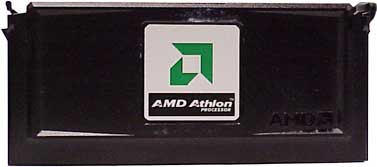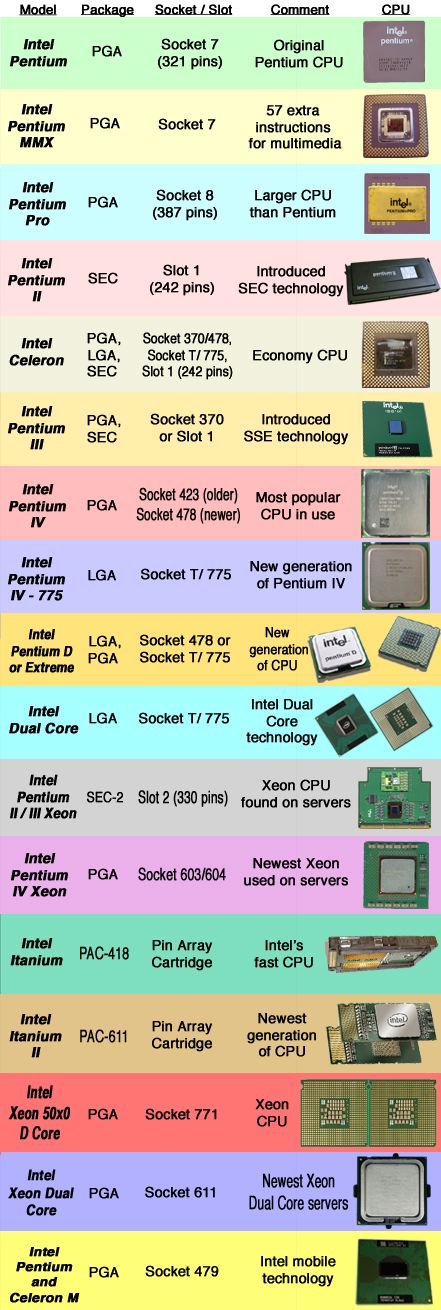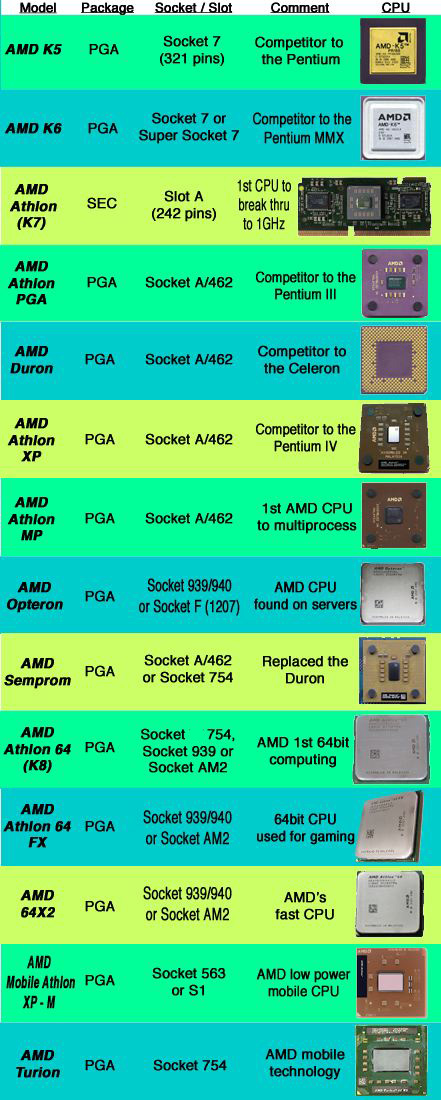
| HOME | TRAINING | SERVICES | BLOG | COMPUTER TIPS | CONTACT US |
CPU
CPU-Central Processing Unit, The CPU is the brain of the computer. Sometimes referred to simply as the processor or central processor, the CPU is where most calculations take place. In terms of computing power, the CPU is the most important element of a computer system.
The
two biggest manufacturers of PC CPU chips are those made by Intel
and AMD other CPU makers
include Motorola, Via, and Cyrix
Central
Processing Unit (The Brain of the Computer)
Two
typical components of a CPU are:
The arithmetic logic unit (ALU), which performs arithmetic
and logical operations
The control unit, which extracts instructions from memory and
decodes and executes them, is calling on the ALU when necessary.
CPU
Terminology
Clock speed: Given in megahertz (MHz) or higher (GHz), the
clock speed determines how many instructions per second the processor
can execute. Also called clock rate, the speed at which a microprocessor
executes instructions. Every computer contains an internal clock that
regulates the rate at which instructions are executed and synchronizes
all the various computer components. The CPU requires a fixed number
of clock ticks (or clock cycles) to execute each instruction. The
faster the clock, the more instructions the CPU can execute per second.
Clock speeds are expressed in megahertz (MHz), 1 MHz being equal to
1 million cycles per second.
1 MHz = 1 million clock cycle
1 GHz = 1 billion clock cycle
Bus Speed
The speeds in which a processor can send data in a pathway.
There measured in the following speeds listed below:
33MHz, 66MHz, 100MHz, 133MHz, 166MHz, 200MHz, 233MHz, 266MHz, 333MHz, 400MHz, 800MHz, 1600MHz, 3200MHz and 6400MHz
Bus Width 32 vs. 64 bit
Address
Bus: Refers to the wires that carry specific addresses to and
from the processor.
Cache: Frequently stored memory, most older CPU's have an L1
internal cache built in with an L2 external cache support chips. Newer
CPU's like the pentium IV have and L1 and L2 cache built in with a
L3 cache
Cache is a very fast memory that is used to hold data and instructions
VRM (Voltage Regulator Mode) Is the circuitry that
sends standard level voltage to the CPU
RISC vs. CISC Reduce Instruction Set Computing vs.
Complex Instruction Set Computing
Math Co Processor Ability of a CPU to perform math
functions and advance calculations
Cooling Mechanism Devices use to cool a CPU (FAN,
Heat Sink and Liquid Cooling) also thermal paste
Overclocking Making a CPU run faster than it should
Front Side vs. Backside Bus How the CPU communicates
with the memory and the cache
Hyperthreading Is a technology developed by Intel
that acts as two processors
Multicore or Dual Core, Triple Core or Quad Core
Has the capability to act
as separate processor in the same CPU
Instruction set: The set of instructions that the microprocessor
can execute.
Bandwidth: The number of bits processed in a single instruction.
Pipelining - Allows a new instruction to start processing
while a current instruction is still being processed.
Branch Prediction - A technique that attempts to infer the proper address of the next instruction while knowing only the current one.
Superscalar execution - Adding one more execution engine in a CPU
Dynamic
execution - Allows the CPU to evaluate the programs's flow
and choose the best order in which to process the instructions
Registers:
Temporary storage areas that hold data before and after processing
by the ALU. It similar to a work table use by the CPU
Computer Packages, Slots and Sockets
SEC- Single Edge Cartridge a new CPU package that is slightly bigger with a built in fan that goes into a SLOT 1 or SLOT A socket.
 AMD
Athlon SEC
AMD
Athlon SEC
SLOT 1 - The form factor for Intel's Pentium II processors The Slot 1 package replaces the Socket 7 and Socket 8 form factors
used by previous Pentium processors. Slot 1 is a 242-contact daughter card slot that accepts a microprocessor packaged as a Single
Edge Contact (SEC) cartridge. A motherboard can have one or two Slot
1s. Some Pentium III and Celeron also use SLOT 1.
SLOT A - Similar to Intel's Slot 1 but used for AMD Athlons
SLOT
2
Slot 2 is a 330-contact use by Intel Pentium II,
III XEON found mostly on server computers
PGA-Short for pin grid array, a type of chip package in which the connecting pins is located on the bottom in concentric squares. PGA chips are particularly good for chips that have many pins, such as modern microprocessors. They go into different types of CPU sockets.
Different types of PGA
SPGA:
Staggered Pin Grid Array
BCPGA: Ball Chip Pin Grid Array
FCPGA: Flip Chip Pin Grid Array
CPGA: Ceramic Pin Grid Array
BPGA-Ball Pin Grid Array

ZIF - Zero insertion force, a chip socket that allows you to insert and
remove a chip without special tools.
Socket - A female connector where a CPU connects

Note * PGA and LGA fits into a socket and SEC packages fits into a slot
Other
CPU packages include the following:
PAC - Pin Array Cartridge (Use in Itanium CPU's)
LGA - Land Grid Array (Newer technology replacing PGA) Use
grid instead of pins
Newer CPU CHART
| CPU | Package | Socket or Slot |
|---|---|---|
| Intel Pentium 4/Core and Celeron | PGA | Socket 423/478 |
| Intel Pentium 4, Extreme, Pentium D, Celeron D, Dual Core, Core2, Duo/Extreme/Quad/Xeon | LGA | Socket T (Socket 775) |
| Intel Pentium, Core, i Series, Xeon | LGA | Socket H (Socket 1156) |
| Intel Core, i Series, Xeon | LGA | Socket B (Socket 1366) |
| Intel iCore 7 Series | LGA uPGA |
Socket B Socket H |
| AMD K7 Athlon, Athlon XP, MP, Duron, Semprom, Geode, NX | PGA | Socket A (Socket 462) |
| AMD K8, AMD Athlon 64, Semprom | PGA | Socket 754 |
| AMD Athlon 64/64X2, Opteron, Phenom, X2/X3, X4, X4 II | PGA | Socket 939/940 or Socket AM2 |
| AMD Athlon II, Phenom II, Semprom | PGA | Socket AM2+, Socket AM3 |
| AMD Athlon 64FX, Opteron | PGA | Socket F (Socket 1207) |
| CPU Servers and Workstations | Package | Socket or Slot |
| Intel Pentium II and Pentium III Xeon | SEC | Slot 2 (330) |
| Intel Itanium | PAC | Socket 418 |
| Intel Itanium II | PAC | Socket 611 |
| Intel Xeon | LGA | Socket 603/604 |
| Intel Core 2, Extreme, Xeon | LGA | Socket J (Socket 771) |
| AMD Athlon 64FX, Opteron | PGA | Socket F (Socket 1207) Socket 940 |
Older CPU CHART
Intel
CPU Chart

AMD CPU Chart

CPU Troubleshooting
Problems with heat (cooling mechanism FAN, Heat Sink and Liquid Cooling)
5 Minute shut down (CPU is overheating)
Listen for fan for breakdown and weird unusual noises
Computer won't start
Computer is acting erratic
Keep air case tight
CPU Compatibility (look at chart)
Overclocking (make sure you have the proper cooling mechanism to support
this or you will damage your CPU)
When installing CPU be careful don't bend or break pins
Match PGA to Socket (ZIF) and SEC to Slot
ZIF (Zero Insertion Force)
Match Pin 1 to the socket or look for notches when installing CPU
Avoid ESD by grounding one's self
Make sure CPU use the proper voltages
CPU
Installation
CPU package must match pin 1 with CPU Socket
Put thermal compound on CPU and install proper cooling mechanism (Fan,
Heat Sink or Liquid)
CPU SEC slide in CPU slot and install proper cooling mechanism (Fan,
Heat Sink or Liquid)
Special
Thanks to Intel and AMD